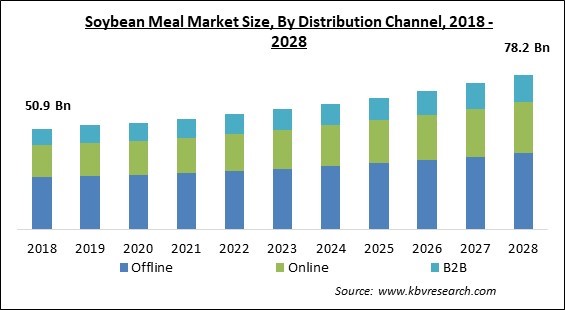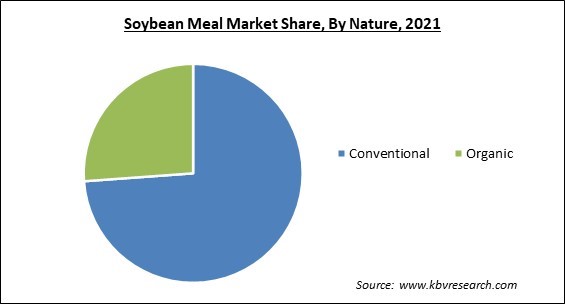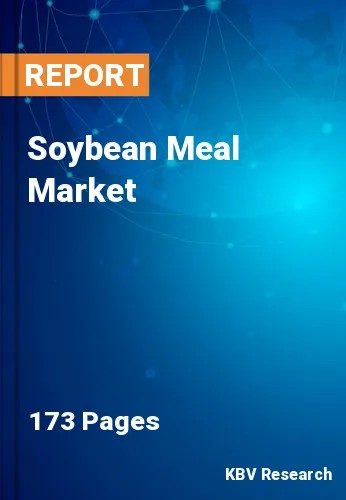The Global Soybean Meal Market size is expected to reach $78.2 billion by 2028, rising at a market growth of 5.1% CAGR during the forecast period.
Animals benefit greatly from eating soybean meal as a feed since it is easily digested, delicious, and provides a huge deal of energy that can be absorbed. Soybean meal may have a CP percentage anywhere from 45–55% and a TDN content anywhere from 75–84%, depending on the amount of dehulling and the processing procedure. The protein has an adequate quantity of all of the essential amino acids; nevertheless, the levels of cystine and methionine fall short of what would be considered optimal.

Methionine may be especially important in high-energy diets since it is the first amino acid that becomes limited. Because of the rapid pace at which CP is broken down in the rumen, large doses have not been given to cattle used for dairy or meat production. Recent years have seen the development of a variety of processing processes for soybeans, all with the goal of reducing the amount of CP that is broken down in the rumen.
The Research Institute for Organic Agriculture reports that in 2019, the organic farming industry brought in a total income of 123 million dollars, created by 3.1 million farmers. (FIBL). In addition, Australia is home to 35.7 billion hectares of organic farmland, making it the country with the most of this kind of land in the world. Following Latin America and Asia with 11% and 5.9% of the global organic acreage, respectively, is Europe with 16.5 million hectares, which is more than 60% of the overall organic acreage.
According to a second set of estimates, the FIBL puts the proportion of organic farmland at 1.5% globally, and this number is growing in tandem with the demand for organic products. In spite of the fact that the majority of top worldwide scientific organizations support genetically modified organisms, more than three-quarters of people throughout the world believe that food items that do not contain GMOs are considerably or slightly healthier. Concern over genetically modified organisms (GMOs) remains high with customers all across the world. In order to meet the rising demand for soybean meal on the market, major firms are also making headway in the research and development of organic goods.
The increasing demand for soybean meal in the food & beverage industries as well as in the production of healthcare items, was one of the COVID-19 pandemic's beneficial effects on the market. However, there has been a minor slowdown in the demand for soybean meal from the feed sector as a result of the decreased demand for meat throughout the globe as well as the closure of animal feed production operations. There has been a rise in the demand for biodiesel all over the world as a significant replacement for conventional diesel and gasoline. Since soybeans are used in the production of biodiesel, this may serve as a driver of expansion in the market for soybean meal during the course of the projected year.
The consumption of soybean meal has grown as a direct result of greater education on the positive effects that the food has on one's health. Because of the high amount of protein that can be found in it, many people believe that it is a good choice for their health. It has been shown that eating soybean meal may lower both total cholesterol and low-density lipoprotein cholesterol levels. As a result, it is anticipated that the development of the market for soybean meal will be fueled by a variety of health advantages as well as an increase in the health awareness of consumers.

One of the primary forces that are fueling the development of the soy protein market for uses in animal feed is the significant demand for naturally occurring resources to enhance the nutrition of livestock and pets. This requirement is one of the key factors propelling the growth of the market. The food and feed sector is reliant on more than 75% of the world's soy production and 65% of all fish harvested for the purpose of maintaining productivity and satisfying the demand of consumers for high-quality foods. There will be a major rise in the need for sustainable animal feed ingredients that are based on protein.
One of the most significant problems that are preventing the expansion of the soybean meal business is the absence of regulatory requirements. This pattern is observably more widespread in nations that have institutionalized regulatory structures that are predicated on scientific risk in order to manage national food safety standards. In the United States, for example, regulatory bodies at the federal and state levels establish stringent guidelines for the constituent parts of foods like soy meal. The use of soybean meal as a dairy replacement is restricted in the United States by legislation governing its use and labeling. Because of these constraints, the market for soybean meal will not be able to expand.
Based on nature, the Soybean Meal Market is categorized into Organic and Conventional. In 2021, the organic segment registered a significant revenue share of the market. The production of organic soymeal results in the creation of a by-product called soy oil meal. Organic soymeal is used in the feeding of a variety of animals, including poultry, cattle, swine, and even pets. An extrusion method is used to clean the soybeans of contaminants like dirt, dust, tiny wooden sticks, and stones that need to be removed before the oil extraction process can begin.
Based on application, the soybean meal market is classified into the food industry, Animal Feed Industry, and Pharmaceutical. The animal feed industry segment held the highest revenue share in the soybean meal market in 2021. During the time of their lives when they are being fattened, cattle are given soy meal to promote healthy and rapid development. This is because it raises the number of fat deposits in the carcass, which enhances the quality of the meal and makes it more appealing to customers. Grass-fed cattle, and especially grass-fed beef, have certain dietary requirements that, in the event that the grass they eat is of low nutritional quality, may be met by supplementing their diet with feeds that are rich in energy or protein.
Based on distribution channel, the soybean meal market is segmented into Offline, B2B, and Online. In 2021, the offline segment had the largest revenue share in the market. This occurs as a result of the increased availability of food and beverage products at stores, which has resulted in a growth in the total amount of shelf space that is now accessible for the marketing of various products. In addition, many companies employ salesmen who are able to provide suggestions on the kinds of foods that may appeal to certain customers. It's possible that conventional buying habits and the price differential between neighboring retail businesses and other wholesale marketplaces are to blame for the expansion of this particular market segment.
| Report Attribute | Details |
|---|---|
| Market size value in 2021 | USD 55.7 Billion |
| Market size forecast in 2028 | USD 78.2 Billion |
| Base Year | 2021 |
| Historical Period | 2018 to 2020 |
| Forecast Period | 2022 to 2028 |
| Revenue Growth Rate | CAGR of 5.1% from 2022 to 2028 |
| Number of Pages | 173 |
| Number of Table | 340 |
| Report coverage | Market Trends, Revenue Estimation and Forecast, Segmentation Analysis, Regional and Country Breakdown, Companies Strategic Developments, Company Profiling |
| Segments covered | Nature, Application, Distribution Channel, Region |
| Country scope | US, Canada, Mexico, Germany, UK, France, Russia, Spain, Italy, China, Japan, India, South Korea, Singapore, Malaysia, Brazil, Argentina, UAE, Saudi Arabia, South Africa, Nigeria |
| Growth Drivers |
|
| Restraints |
|
Based on region, the soybean market is categorized into North America, Europe, Asia Pacific, and LAMEA. The Asia Pacific region accounted for the highest revenue share in the market during 2021. The region accounted for the highest revenue share in 2021. This is mostly attributable to the growing opportunities in the Chinese and Indian markets. The rapidly expanding market for soybean meal in India has contributed to an increase in the country's need for protein, which in turn has resulted in a rise in the demand for soy protein in India.
Free Valuable Insights: Global Soybean Meal Market size to reach USD 78.2 Billion by 2028
The market research report covers the analysis of key stake holders of the market. Key companies profiled in the report include Bunge Limited, Louis Dreyfus Company B.V., Kemin Industries, Inc., The Scoular Company, Mamta Hygiene Products Pvt. Ltd, Mahesh Agro Food Industries, Nordic Soya Ltd., Denofa AS (Amaggi Agropecuária), DHN International, and Minnesota Soybean Processors.
By Distribution Channel
By Nature
By Application
By Geography
The global Soybean Meal Market size is expected to reach $78.2 billion by 2028.
Nutritional advantages as a motivating factor are driving the market in coming years, however, Regulatory requirements and expectations restraints the growth of the market.
Bunge Limited, Louis Dreyfus Company B.V., Kemin Industries, Inc., The Scoular Company, Mamta Hygiene Products Pvt. Ltd, Mahesh Agro Food Industries, Nordic Soya Ltd., Denofa AS (Amaggi Agropecuária), DHN International, and Minnesota Soybean Processors.
The expected CAGR of the Soybean Meal Market is 5.1% from 2022 to 2028.
The Conventional segment acquired maximum revenue share in the Global Soybean Meal Market by Nature in 2021 thereby, achieving a market value of $56.8 billion by 2028.
The Asia Pacific market dominated the Global Soybean Meal Market by Region in 2021, and would continue to be a dominant market till 2028; thereby, achieving a market value of $29.1 billion by 2028.
Our team of dedicated experts can provide you with attractive expansion opportunities for your business.

